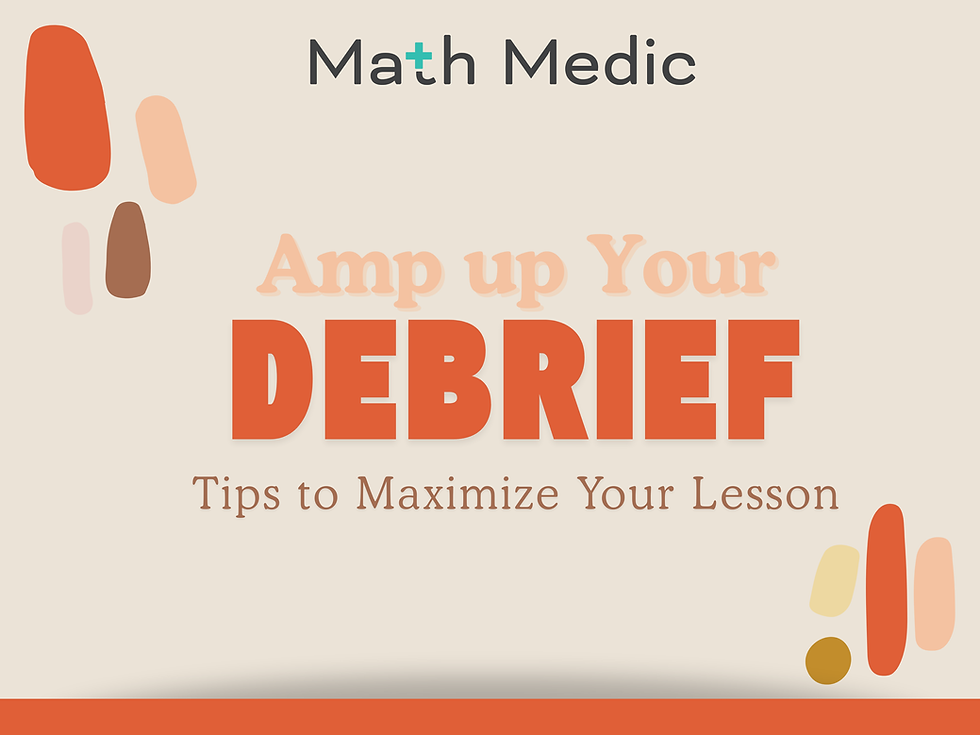5 Probability Strategies to Try Before Using a Formula
- Math Medic

- Oct 30, 2021
- 4 min read
Updated: Feb 15
In our end-of-the-year survey for our students, there is one message that has been consistently clear for many years: Probability is the worst!
But how can this be? With only two formulas, a student can solve most of the probability questions that can come their way.

Understanding the Problem
The problem is that students are far too quick to reach for these formulas. We understand why, as this approach may have served them well in other math and science courses. But probability is different.
For understanding probability, memorizing and implementing formulas just doesn’t seem to work for students.
Here are all the ways that using formulas for probability can go wrong for students:
students don’t remember the correct formula
students choose the wrong formula, or the wrong version of the right formula
students make errors in implementing the formulas, often substituting incorrect values
students get a final answer and don’t know whether or not it is reasonable
All of these student mistakes are easy to explain. Students are missing the fundamental understanding about probability ideas and concepts. They don’t do any thinking and reasoning about the context and information given in the problem before jumping right to the formula. Using formulas as a strategy to solve probability questions obscures the conceptual understanding that is needed for success.
The Solution
Suggest to students that formulas are a last resort. We need to start by trying some strategies that build conceptual understanding of probability concepts. Here are our top 5:
1. Simulation
We can use a simulation to estimate a probability by doing many trials of simulating a random phenomena. We know that as the number of trials increases, the proportion of times that our chosen event occurs will approach the true probability (Law of Large Numbers!).
Example: There are 10 balls numbered 1-10 in a bucket and we randomly choose 3 of them. What is the probability of getting a sum of 15 or higher?

When to use it: Use a simulation for a probability that might be really hard to calculate with a formula because of a complex scenario or difficulty in counting outcomes in the event or the sample space.
Math Medic Lesson: Are Soda Contests True?
2. Sample Space
List out all of the events in the sample space. Circle the ones that are in the event for which you want to calculate a probability.

Example: Toss a fair coin 3 times. What is the probability of getting at least 2 tails?

When to use it: Use the sample space when the number of possible outcomes is reasonably small and easy to write out (or think about). Be sure that each outcome is equally likely if you are going to use this approach.
Math Medic Lesson: Matching Starburst
3. Two-Way Tables
Sometimes we are given counts or percents for two categorical variables for a sample or a population. These counts or percents can be summarized nicely in a two-way table.
Example: 80% of students at East Kentwood High School have an Instagram account, 60% have a Twitter account, and 45% have both Instagram and Twitter. Given that a student has a Twitter account, what is the probability that they have an Instagram account?

When to use it: Use a two-way table when you have probabilities for two events that are not mutually exclusive. Two-way tables can even be used to find conditional probabilities.
Math Medic Lesson: Can You Taco Tongue and Evil Eyebrow?
4. Venn Diagrams
Sometimes we are given counts or percents for two categorical variables for a sample or a population. While these counts or percents can be summarized nicely in a two-way table, many students prefer the more visual approach of the Venn Diagram.
Example: 80% of students at East Kentwood High School have an Instagram account, 60% have a Twitter account, and 45% have both Instagram and Twitter. Given that a student has a Twitter account, what is the probability that they have an Instagram account?

When to use it: Use a Venn Diagram when you have probabilities for two events that are not mutually exclusive. Venn Diagrams can even be used to find conditional probabilities.
Math Medic Lesson: Can You Taco Tongue and Evil Eyebrow?
Notice that two-way tables and Venn Diagrams are BFFs.
5. Tree Diagrams
A tree diagram is an excellent way to visualize a scenario with several different joint probabilities. When a joint probability can be thought of as one event followed by another event, a tree diagram can help students to keep track of all the possibilities and their respective probabilities.
Example: For AP Statistics class this year, 21% of students are Juniors and 79% are Seniors. Of the Juniors, 55% of them are taking another AP course, while 82% of the Seniors are taking another AP course. Given that a randomly selected AP Stats student is taking another AP course, what is the probability that they are a Senior?

When to use it: Tree diagrams are a great strategy to use when there are multiple events happening (or not happening) in a problem and you are given several conditional probabilities.
Math Medic Lesson: Matching Starburst (Part 2)
A Final Thought
Consider giving students a preemptive pep talk before starting the probability unit. Explain to students why relying on a formula is dangerous and encourage them to embrace the many strategies that will be presented in the upcoming lessons. You could even give them this handout, where they can add their strategies as they learn them (the last blank in the handout is for formulas – a last resort!)



